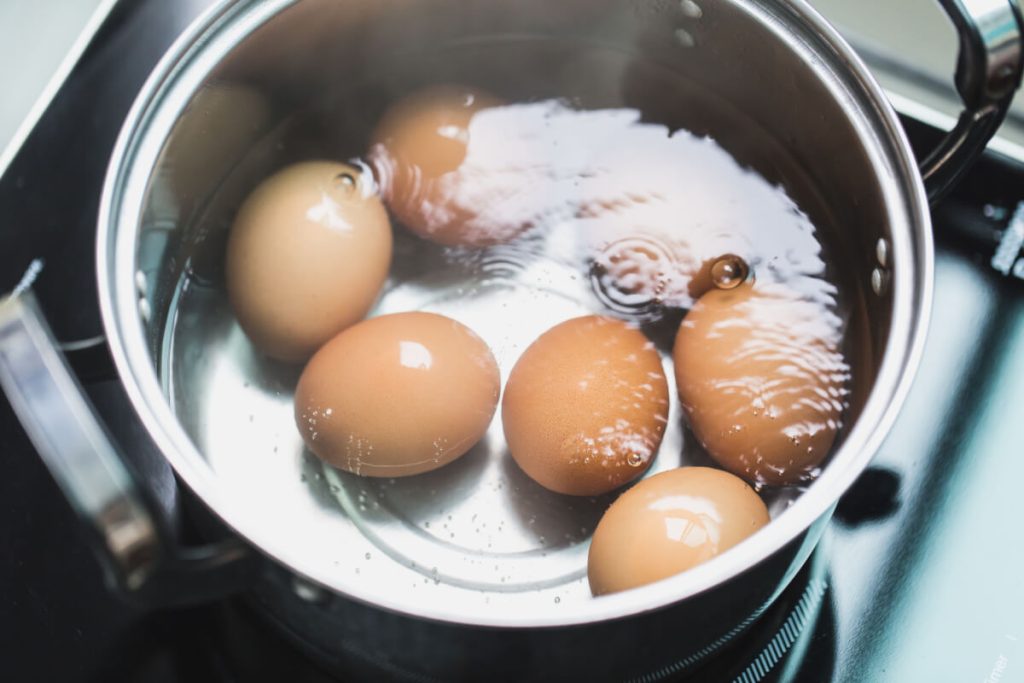

(Credit: © Korn Vitthayanukarun | Dreamstime.com)
NAPLES, Italy — Boiling an egg seems like it should be simple. Yet anyone who’s cut into a supposedly “perfectly” boiled egg knows the disappointment: either a rubbery white with a chalky yolk, or a decent yolk surrounded by raw, runny whites. Now, researchers from the University of Naples Federico II have cracked this culinary code with a revolutionary cooking method that delivers the best of both worlds.
Their solution? A new technique called “periodic cooking” that involves moving an egg between hot and cold water in carefully timed intervals. By switching between boiling water and cool water every two minutes for just over half an hour, cooks can achieve what was previously thought impossible: an egg with properly set whites and a creamy, flowing yolk — all without breaking the shell. A step-by-step process for periodic cooking is included at the end of this post.
What makes cooking an egg so tricky is that the white and yolk need different temperatures to reach their ideal texture. Egg whites need about 185°F to set properly, while egg yolks become creamy and perfect at around 150°F. Traditional cooking methods can’t deliver both temperatures at once, forcing cooks to compromise.
Some chefs have tried to solve this by cooking eggs at a constant lower temperature (called sous vide cooking), but this leaves the whites undercooked. Others separate the yolk and white to cook them individually, a fussy process that defeats the purpose of cooking an egg in its shell.
The periodic cooking method, published in the journal Communications Engineering, takes a different approach. By alternating between hot and cold water baths, it creates different temperature zones within the egg. The outer white gets hot enough to set properly during the hot cycles, while the inner yolk stays at a constant, lower temperature perfect for that creamy texture everyone wants.
To test their method, the research team compared eggs cooked four different ways: traditional hard-boiling (12 minutes in boiling water), soft-boiling (6 minutes in boiling water), sous vide (1 hour at 150°F), and their new periodic cooking technique (alternating between hot and cold water every 2 minutes for 32 minutes total).
The results went beyond just better texture. When the team analyzed the eggs’ nutritional content, they found that periodic cooking actually preserved more of the eggs’ beneficial compounds compared to traditional methods. The gentler cooking process kept more nutrients intact, particularly healthy proteins and antioxidants.
Professional food tasters evaluated all four types of eggs, looking at everything from texture to taste. The periodic-cooked eggs stood out for having whites that were properly set without becoming rubbery, paired with creamy, flowing yolks that maintained their rich flavor. Unlike hard-boiled eggs, there was no gray-green ring around the yolk — a sign of overcooking that many home cooks are all too familiar with.
So the next time you’re craving the perfect egg — one with firmly set whites and a luxuriously creamy yolk — consider giving periodic cooking a try. Just remember: good things come to those who wait… exactly 32 minutes, alternating between hot and cold baths.
How to Make the Perfect Periodic-Cooked Egg
What You’ll Need:
- Fresh eggs at room temperature
- 2 medium-sized pots
- Timer or phone
- Slotted spoon
- Thermometer (optional but helpful)
Step 1: Set Up Your Stations
- Fill one pot with water and bring to a boil (212°F/100°C)
- Fill second pot with cool tap water (around 86°F/30°C)
- Keep both pots on the stove – cool pot on low heat to maintain temperature
Step 2: Start the Cycle
- Gently lower room-temperature egg into boiling water
- Set timer for 2 minutes
- When timer rings, carefully transfer egg to cool water
- Wait 2 minutes
- Return egg to boiling water
Step 3: Continue Cycling
- Repeat this process 8 times total (moving the egg every 2 minutes)
- Total cooking time will be 32 minutes
- Maintain water temperatures throughout process
Step 4: The Final Step
- After final cycle, place egg in cool water for 1 minute
- Gently crack and peel
- Enjoy your perfectly cooked egg with set whites and creamy yolk
Tips for Success:
- Use fresh eggs at room temperature for best results
- Handle eggs gently when transferring between pots
- Keep water temperatures as consistent as possible
- Don’t skip the final cooling step
- If the cool water heats up too much, add a few ice cubes
Pro Tip: This method works best with large eggs. For extra-large or jumbo eggs, you may need to add 30 seconds to each interval.
Time Investment:
Prep time: 5 minutes
Cooking time: 32 minutes
Total time: 37 minutes
The Result: Your egg white should be fully set but tender, never rubbery. The yolk should be creamy and flowing, but not liquid – perfect for everything from breakfast to ramen topping.
Remember: While this method takes longer than traditional boiling, the superior results are worth the extra time and attention. And of course, remember that boiling water can cause severe burns — be careful not to splash or spill any water on yourself during the process.
Paper Summary
Methodology
The study employed a multi-faceted approach combining theoretical modeling with practical experimentation. Researchers first developed mathematical models describing heat transfer and protein denaturation within eggs. These models were then validated using computational fluid dynamics simulations. For physical testing, fresh hen eggs were cooked using four different methods, with temperature monitoring throughout the process. Analysis included Fourier Transform Infrared (FT-IR) spectroscopy to examine protein structures, texture profile analysis for mechanical properties, and trained sensory panels for subjective evaluation.
Results
Periodic cooking produced eggs with significantly different characteristics compared to traditional methods. The whites achieved proper setting (confirmed through texture analysis showing appropriate firmness) while yolks maintained optimal consistency (verified through both instrumental and sensory evaluation). Spectroscopic analysis confirmed different patterns of protein denaturation between the white and yolk regions, indicating successful temperature differentiation within the egg. Nutritional analysis revealed higher retention of beneficial compounds compared to conventional cooking methods.
Limitations
The research focused primarily on standard-sized chicken eggs at room temperature, and results might vary with different egg sizes or starting temperatures. The optimal timing sequence (2-minute intervals) may need adjustment for different conditions. The study did not examine long-term storage effects or food safety aspects beyond basic microbiological considerations.
Key Takeaways
The research demonstrates that controlled temperature cycling can achieve different cooking conditions in different parts of an intact egg. This finding has implications beyond culinary applications, suggesting potential uses in materials processing and industrial applications. The study also highlights the relationship between cooking methods and nutritional preservation.
Funding and Disclosures
This research was funded by the Italian Ministry for Universities and Research under the PRIN 2022 program, specifically project No. 2022SFF349 titled “4D Printing of smart soft robotics (4D P.Ro.).” The authors declared no competing interests.
Publication Information
Published in Communications Engineering (2025), Volume 4, Article 5, by authors from the University of Naples Federico II and the National Research Council of Italy. The paper, titled “Periodic cooking of eggs,” appeared online on February 6, 2025.








